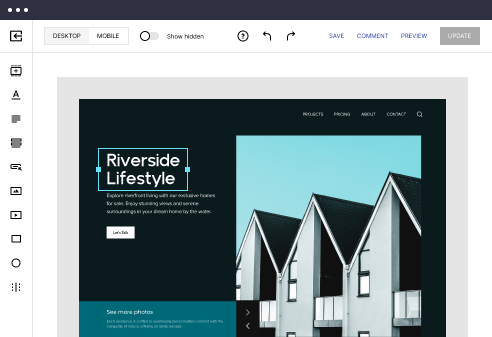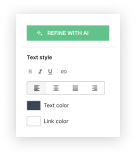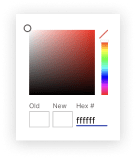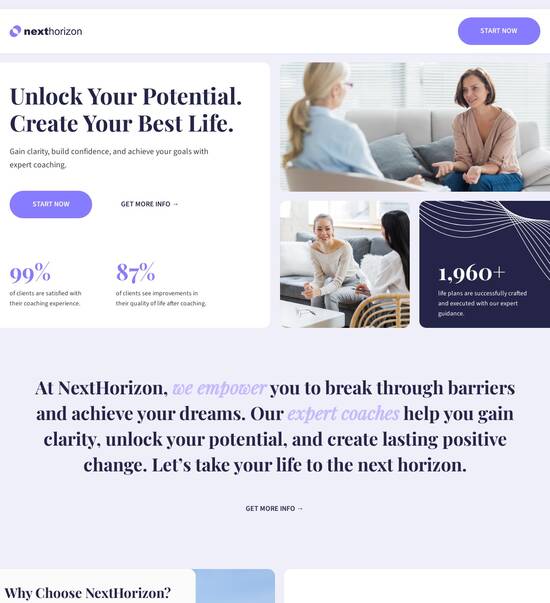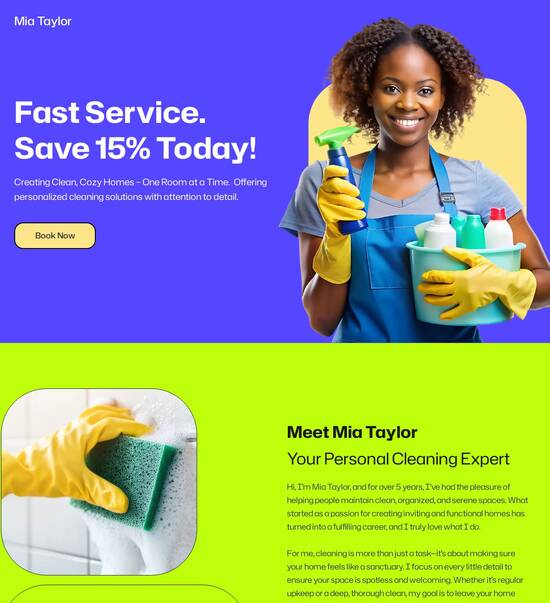
Web page template for React.js developers
Use TemplateAbout template
Attract clients and showcase your skills with style using our landing page templates for React.js developers. Let's convert those visitors into clients!
Recommended templates
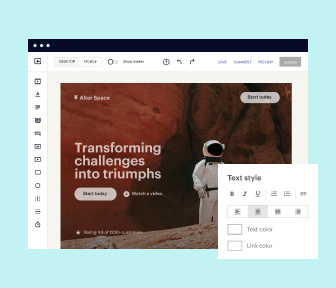
Easy to build without coding
With the intuitive drag-and-drop builder, anyone on your team can create high-converting pages without any knowledge of code or design. Make enhancements to your landing page with custom widgets using Javascript, HTML/CSS, or third-party scripts.
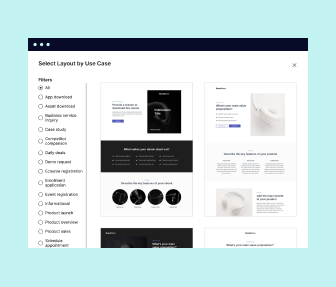
Multiple layouts for any industry and goal
Select from 500+ landing page layouts built to boost conversions across industry-specific scenarios. Customize them by adjusting fonts, adding images, and generating on-brand content with the AI assistant. Quickly scale with Instablocks® and Global Blocks that you can save, reuse, and update globally.
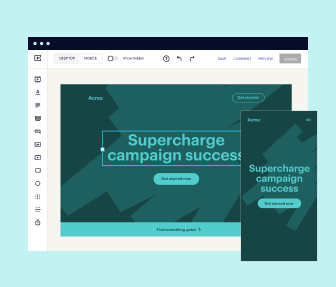
Loads fast and looks polished on any device
Every template is responsive, which means they present professionally on any device and load blazingly fast with our Thor Render Engine. You can also power them up with Google AMP technology to deliver an unparalleled mobile experience and drive higher conversions.
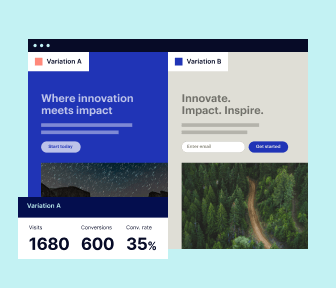
Robust analytics & experimentation
Get real-time updates and reporting across all your devices, showing the number of visitors, conversions, cost-per-visitor, and cost-per-lead. Launch AI-powered experiments, run A/B tests, and use heatmaps to analyze user behavior, then optimize your landing page to maximize conversions.

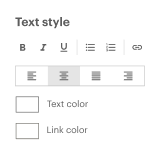
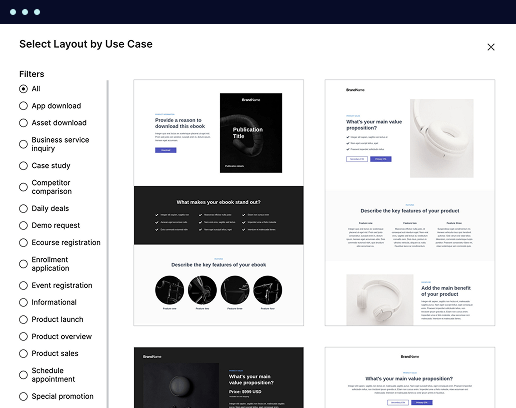
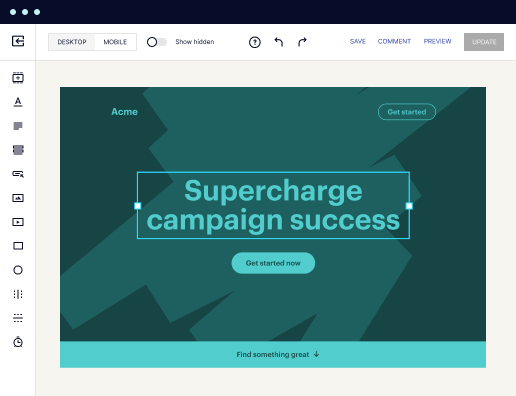
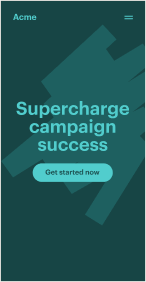
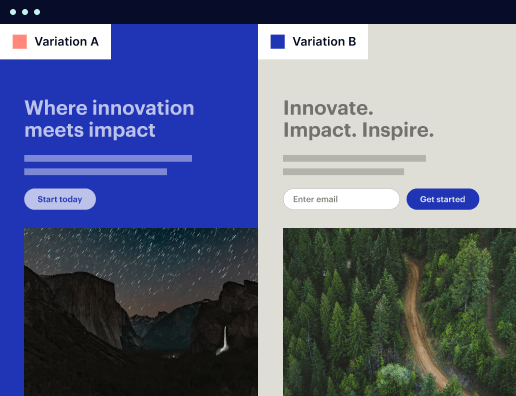

Easy to build without coding
With the intuitive drag-and-drop builder, anyone on your team can create high-converting pages without any knowledge of code or design. Make enhancements to your landing page with custom widgets using Javascript, HTML/CSS, or third-party scripts.
Multiple layouts for any industry and goal
Select from 500+ landing page layouts built to boost conversions across industry-specific scenarios. Customize them by adjusting fonts, adding images, and generating on-brand content with the AI assistant. Quickly scale with Instablocks® and Global Blocks that you can save, reuse, and update globally.
Loads fast and looks polished on any device
Every template is responsive, which means they present professionally on any device and load blazingly fast with our Thor Render Engine.
Robust analytics & experimentation
Get real-time updates and reporting across all your devices, showing the number of visitors, conversions, cost-per-visitor, and cost-per-lead. Launch AI-powered experiments, run A/B tests, and use heatmaps to analyze user behavior, then optimize your landing page to maximize conversions.
All the features you need to build react home page template
Explore more featuresLearn how to build react page template
Frequently asked questions about react site template
Leading the way in building high-performing landing pages





React js website template free download: Your ultimate how-to guide
Building effective landing pages is crucial for marketers aiming to optimize conversion rates and maximize ROI. Instapage's powerful platform offers marketers, regardless of budget or team size, the tools needed to create and enhance their campaigns seamlessly. With over 100 ready-made, high-converting templates, you can launch landing pages that drive results without starting from scratch.
Step 1: Select the perfect landing page template
Choosing the right template is the foundation of your landing page success. Instapage provides a diverse library of customizable templates that cater to various industries like business services, education, and tech. Here’s how to get started:
- Choose from 100+ templates: Access templates designed for high conversions.
- Utilize pre-built lead generation forms: Integrate forms directly into your landing page easily.
- Customize to fit your brand: Modify colors, fonts, and images to align with your branding.
Step 2: Optimize landing page for conversions
Optimization is key to achieving your campaign goals. Instapage equips you with features that allow you to experiment and fine-tune your pages based on real user data. Consider these strategies:
- Conduct A/B testing: Test different headlines, images, or CTAs to identify what works best.
- Analyze heatmaps: Understand user behavior and see where visitors are clicking.
- Utilize analytics dashboard: Track performance metrics to make data-driven decisions.
Step 3: Personalize your landing page experience
Personalization can significantly impact user engagement and conversion rates. Instapage allows you to create dynamic content tailored to different audience segments. Here’s how:
- Dynamic text replacement: Automatically change text based on user data to resonate with visitors.
- Utilize AdMaps: Align specific ads with tailored landing pages to improve relevance.
- Segment audience tracking: Use tracking tools to measure how various segments are interacting with your content.
With these steps, you can effectively leverage Instapage's tools to maximize your marketing efforts and drive higher conversions on your landing pages.
In conclusion, utilizing a robust platform like Instapage can transform your landing page creation process, making it more efficient and targeted toward achieving your marketing goals.
Ready to elevate your landing page strategy? Start your journey with Instapage today and see the difference it can make in boosting your conversion rates!
Web page templates for ReactJS developers: A comprehensive guide
Understanding the importance of web page templates for ReactJS development
The landscape of web development has transformed dramatically over the past two decades. Initially, developers relied heavily on manually coding websites from scratch. However, as the demand for faster and more efficient development processes grew, web templates emerged as a solution. ReactJS, a library created by Facebook, provides a powerful framework that allows developers to build interactive and dynamic web applications efficiently. The introduction of web page templates specifically designed for ReactJS has further revolutionized the way developers approach their projects.
ReactJS gained popularity among developers due to its component-based architecture, facilitating code reuse and improved manageability. This approach has made it a go-to library not only for building user interfaces but also for creating comprehensive applications. As digital products proliferate, the synergy between ReactJS and web page templates has become essential for streamlining development, ensuring high-quality outputs while minimizing time spent on repetitive tasks.
Evolution of web development practices.
The growing adoption of ReactJS across various sectors.
The integration of templates enhancing development efficiency.
Defining web page templates for ReactJS
Web page templates serve as foundational elements for building web applications efficiently. These templates include a combination of HTML, CSS, and JavaScript code that simplifies the design and functionality of a webpage. In the context of ReactJS, templates often include pre-defined components that allow developers to focus more on specific features and customization rather than starting from scratch. It’s crucial that these templates are responsive and compatible across various devices and browsers to ensure a seamless user experience.
There are several types of web page templates tailored for ReactJS developers, each serving different needs. UI templates focus on creating engaging user interfaces, while e-commerce templates provide essential features for online stores. Portfolio templates enable creative professionals to showcase their work effectively. The customizable nature of these templates allows developers to adapt designs to fit unique branding and functionality requirements.
UI templates: Ready-to-use components for user interfaces.
E-commerce templates: Pre-built solutions for online retailers.
Portfolio templates: Structures tailored for showcasing work.
Features of a great template for ReactJS developers
A well-designed web page template should prioritize user-friendly design, making it straightforward for developers and designers alike. Intuitive layouts not only facilitate better designs but also enhance developers' productivity. Clear navigation and strategically placed elements contribute to effective user experiences. Additionally, aesthetics and functionality should not be sacrificed, as a visually appealing interface can significantly impact user engagement.
Templates should also provide compatibility and integration with various libraries and frameworks. This encourages developers to use their favorite tools while enhancing the template's functionality. Frameworks such as Redux for state management or Axios for API requests can seamlessly fit into these templates, enabling developers to create more feature-complete applications. Performance optimization features, such as efficient loading speed and minimal code bloat, are essential to retain user interest, making speed a critical factor in template design.
Intuitive layouts and usability.
Compatibility with libraries and plugins.
Performance optimization considerations.
In-depth look at developer-friendly React dashboard
When designing a React dashboard, customization capabilities play a pivotal role. The component-based architecture of ReactJS allows for a high level of customization, enabling developers to tailor their dashboards according to specific project requirements. This flexibility ensures that developers can create a user experience that aligns with their app’s goals while delivering the necessary functionality. Examples of personalized dashboards include admin panels with user management, analytics displays, and task tracking systems.
Navigation and usability are key features of effective dashboards. A developer-friendly interface has to prioritize user experience, allowing for intuitive interactions. Features such as drag-and-drop functionalities and modular component arrangements ensure that developers can work efficiently while personalizing their dashboards to accommodate evolving needs. Furthermore, integrating analytics and insights tools into these dashboards empowers developers to monitor performance metrics effectively, allowing for data-driven decision-making.
Customizable component structures for tailored experiences.
User-friendly navigation mechanisms.
Integration of analytics tools for performance insights.
Exploring popular selling templates for ReactJS
With the growing popularity of ReactJS, a multitude of platforms now offer an extensive library of templates for developers. The flexibility and variety of choices available make it easier for developers to select templates that suit their unique needs. Each platform has differentiating factors such as cost, customization options, and customer support. Sites like ThemeForest, Creative Market, and TemplateMonster have established themselves as major players in the template market, giving developers access to diverse designs.
A notable mention is Tailwind React templates, which leverage the Tailwind CSS framework's utility-first approach. This allows developers to customize their designs right down to the minute details without worrying about specificity conflicts. Tailwind templates provide visually pleasing interfaces out of the box while allowing for extensive customization. Similarly, Bootstrap templates integrate well with the ReactJS ecosystem, ensuring responsive design and quick-loading features that can be beneficial for developers looking for pre-designed solutions.
Variety of templates on platforms like ThemeForest.
Benefits of using Tailwind CSS for customization.
Responsive advantages of Bootstrap templates.
The developer and designer synergy
The collaboration between developers and designers can often be streamlined through the use of web page templates. These templates serve as a foundational communication medium that enables both parties to align their vision for a project. By integrating templates into their workflow, teams can more efficiently exchange ideas and feedback, ensuring that the final product meets both user and business requirements. Tools such as Figma and Adobe XD further enhance this collaboration, allowing teams to visualize designs before implementation.
Aesthetic choices play a crucial role in the success of any web application. The influence of engaging design on user experience, retention, and overall brand perception is significant. When developers and designers work together effectively, the final result is often more harmonious, leading to an increase in user engagement and satisfaction. The strategic application of web templates can also provide common ground for aesthetic debates, focusing discussions on improving user experience rather than diving into details.
Collaboration tools streamlining teamwork.
The importance of cohesive design and branding.
Shared templates facilitating communication.
The business impact of using web page templates
Utilizing web page templates can significantly enhance cost efficiency for agencies and independent creatives. By limiting the amount of custom development required, templates minimize both development costs and timelines, allowing teams to focus on higher-value tasks. Many businesses have realized substantial savings, enabling them to allocate resources to other growth initiatives, such as marketing and product development. In this way, the strategic use of templates can lead to competitive advantages in fast-paced environments.
Increasingly, developers and agencies are recognizing the monetization potential of customizable templates. By licensing their templates to other users or creating tailored solutions for specific clientele, they create an additional revenue stream. Licensing options offer flexibility for developers, while businesses can capitalize on well-designed templates to speed up their launch cycles. Ultimately, leveraging these templates not only reduces costs but also enhances monetization strategies, marking a critical intersection between design and business development.
Cost savings through efficient template usage.
Monetization options through licensing.
Competitive advantages from quicker delivery.
Navigating the app directory for the best templates
Choosing the right template from a plethora of options can be daunting for developers. However, setting clear criteria regarding features, support, and user reviews can help in navigating this overwhelming landscape. Prioritizing practical usability and appealing design aesthetics ensures that the final selection will align with the intended project goals. A simple checklist can help guide the decision-making process, focusing on the must-have features and overall template performance.
Once a template is chosen, implementing it effectively is crucial. Common challenges in template integration include compatibility issues, limited customization options, and understanding how to utilize the template’s core components. Developers should educate themselves on the documentation provided by template creators and engage with community forums for troubleshooting. Case studies showcasing successful template deployments can provide valuable insights for best practices, assuring that the implementation phase runs smoothly.
Key criteria for selecting templates.
Common challenges in template integration.
Learning from case studies for effective implementation.
Future trends in web page templates for ReactJS
As web technologies evolve, so too will the design of web page templates for ReactJS developers. Emerging technologies such as artificial intelligence and automation are beginning to enhance the template creation process, allowing developers to generate dynamic templates with minimal input. This progress will likely result in more sophisticated template designs, featuring built-in capabilities that adapt to user behavior and preferences while maintaining responsiveness across platforms.
Looking ahead, we may see a growing emphasis on accessibility in template design. Ensuring that templates are inclusive and cater to diverse user needs will become increasingly crucial. Developers will need to consider best practices for accessibility from the ground up, ensuring templates are equipped with necessary features to support varied user interactions. Anticipating these trends will be essential for developers aiming to stay ahead in an ever-changing digital landscape.
AI and automation influencing template creation.
Future features focused on user behavior.
Increasing importance of accessibility.
Engaging with the community and feedback
Connecting with relevant communities is invaluable for ReactJS developers working with web page templates. Platforms such as GitHub, Reddit, and specialized forums allow developers to share insights, seek advice, and explore new trends. Engaging regularly in these communities fosters collaboration, giving developers the opportunity to receive and provide feedback on template designs and usability. Leveraging peer experiences not only improves individual understanding but enriches the collective knowledge pool.
Learning from case studies shared within these platforms offers valuable lessons and techniques for improvement. Developers can apply insights from these discussions to refine their approaches, whether in selecting templates or during implementation phases. Exchanging knowledge and experiences with peers promotes innovation, ultimately leading to better development outcomes and a more robust community.
Popular platforms for community engagement.
Encouraging feedback loops for improvement.
Sharing insights from peer experiences.
Mastering customization with Tailwind dashboards
Tailwind CSS has emerged as a popular framework among developers for crafting customized web applications, especially for those using ReactJS. Its utility-first design principles promote a straightforward approach to building layouts that are not just aesthetically pleasing but also functional. Tailwind's components can easily be combined to create varied layouts that appeal to different user preferences, allowing for significant customization without the overhead of defining multiple styles or classes.
To create a Tailwind React template, developers can begin by defining the core structure of their application and utilizing Tailwind's utility classes for styling components. A step-by-step approach involves focusing on essential elements like headers, footers, and content sections while using Tailwind’s available utilities to enhance designs. By integrating plugins and tools tailored for Tailwind CSS, developers can also leverage additional functionalities ensuring their templates meet diverse application needs.
Key principles of utility-first design.
Creating structure using Tailwind components.
Integrating tools for expanded functionality.
Ready to skyrocket conversions?
Supercharge your ad campaigns with high-performing landing pages
Get started